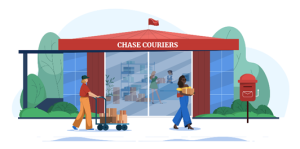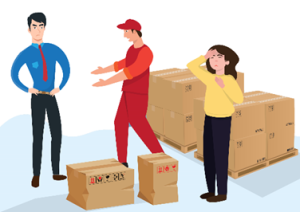
Another day at Chase Couriers, and another headache for Tarina. Or perhaps it would be more accurate to say, another iteration of a headache that was becoming depressingly familiar. Tarina was the Operations Manager at Chase, which meant that she was responsible for all the packages getting processed and delivered by her team to where they were supposed to be. Being a courier service, speed was a high priority. On the other hand, it didn’t do any good to deliver things quickly, but to the wrong place, so accuracy was important too. Having the claims team trying to find lost or misdelivered packages, landed for Tatiana as a personal failure, and didn’t do anything good for the delivery schedule either! And it was trying to satisfy both of those imperatives that gave Tarina the same recurring headache.
The problem was that the pick-up and delivery locations of the packages weren’t conveniently distributed. Some locations often got a lot of packages sent to them while others didn’t, but you couldn’t predict the load for any particular location on any given day. That meant that the loads of packages to go on any particular courier run usually varied from day to day. Sometimes, the loads got too big for the usual courier drivers to handle, and drivers had to be reassigned from other runs to deal with the increased load… but which drivers to reassign, and which runs to assign them to, was where Tarina’s headache came from.
The obvious thing to do was just pull drivers from any run that wasn’t overloaded and assign them to whichever courier run had the biggest queue, but that didn’t work all that well. Tarina had quickly given up on doing that because drivers who weren’t familiar with the run they were reassigned to were inevitably slower. Worse still, they made significantly more collection and delivery errors, so the rate of correct on-time deliveries dropped and the loads of packages awaiting delivery never seemed to dwindle as fast as expected. Deliveries had to be made during normal business hours, so drivers would keep coming back with undelivered packages, which just compounded the problem and rolled the load into the next day, making matters worse again.

Unfortunately, it wasn’t really practical to just assign drivers to the runs they knew best, either. That just left some drivers idle when their run didn’t have many deliveries, while others were massively overworked. And which was which could change from day to day, too. This variation meant large piles of packages would take too long time to clear and the rolling overloads threatened to block up the entire delivery side of the business. With deliveries getting stuck, it got even harder to get packages delivered on time. Costs were rising yet somehow the piles never seemed to diminish much.
There had to be a better way of doing things, and Tarina needed to find it badly. Until a better way showed up, though, Tarina decided that at least she could try to stop the backlog of undelivered packages from getting quite so big in the first place. Instead of reassigning drivers to the run which had the biggest backlog of deliveries, Tarina started reassigning drivers to the runs which had loads that were increasing, even if they didn’t have the biggest loads yet. Her logic was that if she didn’t attend to those loads first, as the packages piled up, pretty soon one of them would become the new ‘clear it now’ backlog, and she’d be assigning the drivers to it anyway. If she jumped on them fast, however, she might not need to assign so many drivers to bring the rising queue under control, and that meant the other piles would stay under control – or at least, she hoped that’s how it would work out. Although other loads might be bigger, the fact that they weren’t rising made it seem like they were already under control. At first, Tarina only had partial success with her idea. It worked OK in the cities, but rural delivery routes were much further apart, and drivers started complaining every time they had to travel to a new delivery route.

The other main problem Tarina encountered with her idea was trying to figure out how to figure out how fast each pile of packages for deliveries was rising. Just counting the number of deliveries that had to be made didn’t work, because lots of deliveries that were close together took less time to clear than a few deliveries that were spread out all along the courier run. What Tarina really needed to know was how much delivery time was represented in a pile… and that was the second problem she encountered because it turned out that the courier drivers were extremely reluctant to predict that. Presumably, that was because they were afraid of what might happen if they guessed wrong, and it took Tarina quite a while to convince them that their guess wouldn’t be used against them, and in fact, it didn’t have to be all that accurate. Just a rough figure was all she needed, or a range of values because they could revise their estimates later once they had seen how things developed.

The third problem was that people didn’t like to appear idle. Which was fair enough, really, but courier drivers with small loads started taking longer to make all their deliveries, just so they wouldn’t have to stand around at the depot looking embarrassed, or worse lose their run to another courier. That issue took longer to resolve. Tarina dealt with it by encouraging drivers to use their idle time to either make any improvements they’d been thinking of that might make things easier for them, or to get familiar with different courier runs. These ‘idle’ activities had the side benefit of making the drivers more effective, either on their runs or when they were reassigned, so it was really not hard for people to see the benefits of them.
Once all these issues had been overcome, the benefits of throwing resources at rising queues of work, rather than whatever queue of work was biggest, became fairly clear. Deliveries got stuck in piles increasingly rarely, and the rate of correct deliveries showed a significant improvement too. Oddly enough, it seemed like some of the drivers had started looking at things differently, too. They were starting to refer to deliveries in terms of time rather than the number of items, and asking uncomfortable questions about whether this should be applied in other delivery centres or for international deliveries too. Which wasn’t a bad question, actually…
